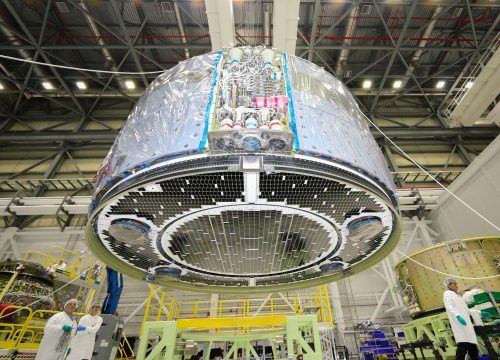On its maiden flight, the Starliner spacecraft failed to reach the International Space Station. A previous launch attempt was canceled due to a malfunction in the parachute that was discovered during the tests. The malfunction is added to the crashes of the 737 Max planes.

Update - 23/12 at 23:15 p.m.: Boeing's board of directors announced the departure of CEO Dennis Muilenburg, one day after the landing of the Staliner spacecraft at the White Sands missile base in New Mexico. Muilenburg's dismissal is effective immediately. Boeing Chief Financial Officer Greg Smith will serve as interim CEO until Chairman David Calhoun takes over as permanent CEO on January 13.
The original knowledge
Boeing's space division failed another test this week when an engine in its Starliner spacecraft failed to put the unmanned spacecraft on the correct trajectory to rendezvous and dock with the International Space Station.
According to experts, even the failure of the mission, despite the successful landing, will be seen as particularly painful for Boeing, which is experiencing a safety crisis in its grounded 737 Max planes. The final rehearsal before the flight will operate will be seen as particularly painful for Boeing, which is facing a safety crisis on its grounded 737 MAX planes.
In 2014, three years after the termination of the transition program, NASA awarded contracts to Boeing and SpaceX in the amount of eight billion dollars to provide transportation services to American astronauts. The companies must provide six flights of spacecraft, each time they will be required to bring four astronauts to the space station.
Both companies are two years behind schedule, but unlike Boeing, SpaceX performed a successful autonomous rendezvous and docking with the International Space Station in March of this year.
A report by the NASA auditor indicated that the launch cost for each astronaut flying on Boeing's Starliner would be $90 million, compared to $55 million for SpaceX. Today, NASA pays Russia 80 million dollars for each astronaut it sends to the space station for NASA.
In addition to evaluating the new vehicle in Earth orbit, the goal of the long-delayed test flight was to demonstrate the Starliner's ability to take people and cargo to the space station. SpaceX has repeatedly demonstrated its ability to transport cargo to the space station and return experiments from it.
Despite a spin of self-congratulations on social media for a successful launch, the fact remains that Boeing has once again failed to meet its contractual obligations to NASA. The Starliner reached orbit, but not its intended destination.
Despite these and other setbacks and missed deadlines, the space agency continues to pay Boeing handsomely. Therefore it has no great incentive to provide a space vehicle that is able to perform the mission on time and even less so within the budget.
At first, Boeing officials blamed the failure on a timing problem immediately after the vehicle separated from the launch vehicle. According to the NASA Watch website, company officials said the Starliner separated from the rocket as planned. An error in the mission clock (MET) system was cited as the reason for the failure to ignite the engine for orbit entry.
It turned out that the spacecraft engine was not synchronized to the correct time in the ignition sequence. When the engine was already ignited, according to reports, there was not enough propellant left to reach the space station.
These blunders are reminiscent of the infamous 1999 Mars Climate Compass mission where engineers forgot to convert English measurements to decimals in the data exchange with the spacecraft.
Boeing's other excuse for failure, at least initially, was the lack of coverage by communications satellites that prevented the controllers from sending the Starliner engine a timely ignition command.
The launch windows are set months in advance. How did the flight controllers not prepare to communicate with a space vehicle on its maiden flight?
NASA head Jim Bridenstine also blamed the flight's automation process and said: "If we had astronauts on board, they could have flown it manually. And in any case, there wasn't even one second when they felt unsafe."
The failure to enter orbit this week comes after an aborted launch test in November when one of the Starliner's three parachutes failed to deploy. This redundancy in the design allowed the vehicle to land safely, but Boeing engineers eventually determined that the malfunction was caused by a pin failure that was not properly connected to the parachute cord. A lack of attention to detail like this can have fatal consequences in an unforgiving activity like space flight.
Of course, many things can go wrong on a maiden flight. But Boeing engineers have had years to get it right. And they did not lack government resources to meet the goals of their mission. Boeing received a $4.2 billion contract in 2014 to develop a space vehicle that would carry astronauts to the International Space Station.
The analysts conclude that after five years, Boeing still has not delivered the goods.
"Starliner is designed to carry astronauts to the International Space Station, ending the US's dependence on expensive Russian launch services. That goal is still out of reach until Boeing or SpaceX prove that it is safe to launch people in their spacecraft."
More of the topic in Hayadan:
- Two days after the launch failure, Boeing's Starliner lands safely in New Mexico
- A malfunction in Boeing's Starliner spacecraft prevented it from reaching the space station * The spacecraft is supposed to carry astronauts to the station in the future
- Boeing and SpaceX won the NASA tender to fly astronauts to the space station (2014)

One response
I'm the only one who noticed that Boeing's spacecraft costs almost double that of SPACEX and 10 million dollars more than a Soyuz launch and they still got a contract?